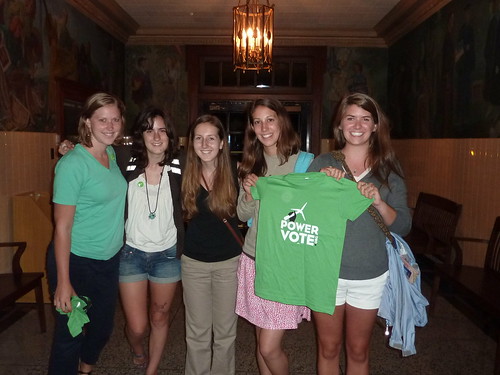MARYLAND’S FIRST 90% RENEWABLE-ENERGY HOME
The story of how one Takoma Park family is fighting global warming on a budget, and how you can do it too
By Mike Tidwell
It’s a lovely, breezy, autumn day, temperature in the forties, not a cloud in the sky. Inside my house I set the heat at a toasty 70 degrees then reach for a cold beer from the refrigerator while turning the television to an NFL football game. Later I’ll unwind with a hot, steaming bath while listening to classical music CDs.
Just another glorious day of modern Western life — and profligate energy use — leading inexorably to runaway global warming, right?
Wrong. All but a small fraction of my household energy budget comes from renewable, CO2-neutral sources. The electricity arrives from photovoltaic panels on the roof, the heating from an electronically-controlled pot-belly stove that burns corn kernels and warms most of my Takoma Park home, and the hot water from a separate rooftop panel that converts sunlight to infrared heat.
Obviously, I’m a very wealthy man to be able to afford such extravagant gadgets. Everyone knows that amazingly effective renewable-energy technologies are out there. The problem is that average Americans — the very people who need to switch if we’re ever going to stop global warming — simply can’t afford them. Right?
Wrong again. In my case, I’m a hopelessly middle-class, self-employed writer with a nine-year-old son. No rich uncle died allowing me to become a self-indulgent techno nerd. And I didn’t scrape together years worth of savings to make this dream come true. I made all of the energy changes abruptly, within six months, and now I’m spending the handsome sum of — get this — $30 per month to pay for them.
That’s all. For the cost of a cup of coffee a day, with no help from friends or relatives, I’ve gotten off the planet’s back almost entirely at my home. And here’s the best part: Most of these planet-saving technologies are available and affordable right now for many American homeowners willing to do a little bit of research, borrow a modest sum of money, and spend that money wisely.
For me it was last year’s bombshell findings of the U.N.-sponsored Intergovernmental Panel on Climate Change that motivated me to plot my home energy revolution. Disastrous planetary warming of up to 10.4 degrees by 2100 is doubly horrifying each time you look out at your innocent son playing whiffle ball in the backyard with playmates destined to live till 2070. I knew that the relatively modest targets set by the Kyoto protocol wouldn’t save the planet either. Most scientists believe the world’s CO2 emissions must drop a full 80 percent below current levels to stabilize the climate.
So that became my goal: 80 percent. If I could cut my household CO2 emissions by that amount — or at LEAST by 50% — I would have done my part. It was the least I could do in a nation where our government barbarically sabotages even modest international efforts to stem climate change while proposing no solutions of its own. If our leaders won’t lead, we Americans owe it to the rest of the world to get the job done on our own, house by house, neighborhood by neighborhood.
So I developed a budget: $7500. That’s what I would spend, no more. Being of modest means, I had to borrow the money in the form of a home equity loan.
My very first investment was a book called Homemade Money, published by the Rocky Mountain Institute for people wanting to save money through improved energy use. The first step, I learned, was to eliminate unnecessary energy consumption and to use more efficiently the energy you can’t live without.
So I switched to compact fluorescent light bulbs, bought an extremely high efficiency refrigerator (it consumes less than a third the electricity of my previous 10-year-old unit and is bigger) and I began drying my clothes on a line. With these and other painless changes, including never ever illuminating an unoccupied room, I cut my electricity use a remarkable 52 percent from 3760 kilowatt hours in the year 2000 to an annual rate of around 1800 kilowatt hours now.
With my electricity demand now well trimmed, it became plausible to meet at least part of that demand with my own solar generation. And here’s where I encountered the first of several big and pleasant surprises: I could go solar, in a very big way, even on a very tight budget. I quickly learned that my state of Maryland offers grants of up to $3600 toward solar photovoltaic systems plus a deduction of 15% of the cost of the system from my state income tax. With a hefty grant in hand, I went shopping for solar panels and got another big surprise: A solar advocacy group – the Virginia Alliance for Solar Electricity — was heavily discounting the price of panels thanks to a subsidy from the U.S. Department of Energy. Taking advantage of both of these programs (both open to all homeowners in Maryland, by the way) and installing much of the system myself, I was suddenly able to realize my greatest dream: 36 solar panels on my southeast-facing back roof generating 70 percent of my electricity.
Amazingly, having tackled the big hurdle of electricity, I had almost half of my original $7500 budget still in hand to apply to my next big challenge: heating my house. I knew from research that a typical American household spends 44 percent of its total energy budget heating and cooling the home. As for cooling, my sturdy old house has high ceilings, partial shading from trees, and a nice sleeping porch, so I get by with ceiling fans. But in winter I spend up to $300 a month heating with natural gas. Given that my house was already reasonably well insulated, there could be no new savings through conservation. So I had to find a new source of heat.
But what? Thankfully, a small company in Hutchinson, Minnesota answered the question. Twelve years ago, ex-farmer Mike Haefner, president of American Energy Systems, engineered the first ever corn-burning stove designed to heat modern homes. Sales were flat until last year when rising fuel prices and growing concerns about the environment increased company sales 500 percent. This relatively small and easy-to-install stove easily heats a two-thousand-square-foot home (mine is 1600 square feet) and can accommodate a thermostat for extra convenience. The stove can store up to two days worth of corn in a side bin and self-loads the corn with a low-energy electric auger. All you have to do is set the stove to the heating level you want and enjoy the radiant heat.
Burning corn contributes almost nothing to global warming if the corn is raised responsibly through “no-till” planting and organic fertilization. Like all plant material, corn absorbs CO2 as it grows, and, with this stove, the corn burns so efficiently that the net CO2 released is at least 85 percent less than with natural gas heating. Moreover, corn is cheaper than natural gas — I save $200-$600 per winter — and it’s easily purchased here in the Washington area thanks to the urban corn silo and corn home-heating cooperative I’ve set up with 16 other local families. And corn is an almost endless energy source. Studies show American farmers can grow ten times more corn than is needed to meet all of America’s energy needs. So it’s good for farmers, good for the climate, easy to use, saves money. No brainer.
Even after all of these purchases — fridge, bulbs, photovoltaic panels, stove — I still had enough money to tackle my last major source of greenhouse gas emission: Heating my water. And here I got lucky. My heroic local solar contractor stumbled across a used but perfectly good 5-year-old solar hot-water system and sold it to me installed for $1000, thus closing out my expenditures at just over $7500. The solar system “pre-heats” the water for our natural gas heater. Thus, on sunny days, all of my hot water comes from the sun and on cloudy days I get as much help from solar as I can and then the gas burners kick in to
bring the temperature up to the 110 degrees I desire. I’m thus guaranteed hot water year round no matter what the weather.
Solar hot-water systems sell new starting at $3500 installed, so I caught a big break by buying mine used, the only sweet deal in my mix of energy investments, however. Maryland permits home owners to deduct 15 percent of the cost of such systems from their state income taxes, and if you use hot water for your dishwasher and for washing clothes, your pay back can come in less than ten years.
For my own purchases, here’s the bottom line: Except for a little natural gas to cook my food and heat my water on really cloudy days, plus the small portion of my electricity that still comes from my local utility, I now contribute nothing to global warming through home energy use. In the process, I’ve reduced my estimated CO2 contribution from 19,488 pounds per year to just under 2010 pounds, a drop of almost 90 percent!! If every household in the industrialized world were to make only half of these changes we would be well on our way to solving global warming.
I also do well by doing good. By conserving energy and switching to renewables I save an estimated $684 each year. That’s $57 per month. My monthly payment for the $7500 loan is $87. The difference is a little more than a dollar a day, a minuscule price to help preserve the planet. And that sum will quickly diminish as energy prices continue to rise. In ten years, when my loan is repaid, savings probably close to $1000 per year will go straight into my pocket.
But what are the drawbacks? Where’s the catch? Surely such an abrupt switch from fossil fuels entails some hidden sacrifices.
Actually, there are none. Yes, several times a week in the winter I have to reload the stove with corn, which takes about five minutes. And every two weeks I have to clean the stove a little and empty the ashes: another 15 minutes. And since the stove radiates heat, a room can only be warm if its door is left open, meaning someone wanting an extended period of complete privacy might get a little chilly. Other than this, my life of modern comfort is essentially unchanged.
Except for one more thing: I now live with greater hope for my son’s future and that of the whole planet. If I can make such big changes so quickly and for so little money, the rest of the world, when it finally makes up its mind, can do the same.
(Mike Tidwell is a writer and climate change activist in Takoma Park, Maryland. He can be reached at mtidwell@gmail.com)
WHAT I BOUGHT:
1.5 kilowatt photovoltaic system (partially installed by author): $3396
CO2-neutral corn-burning stove: $2,400
Solar hot-water system (used): $1,000
High-efficiency refrigerator: $750
20 compact fluorescent light bulbs: $140
Total: $7,686
HOW I PAID FOR IT:
$7,500 ten-year home equity loan at 7% interest rate. Monthly payment: $87.
Monthly energy savings: $57.
Final cost of converting our house almost entirely to renewable energy: $1
per day (until loan is paid off.)





